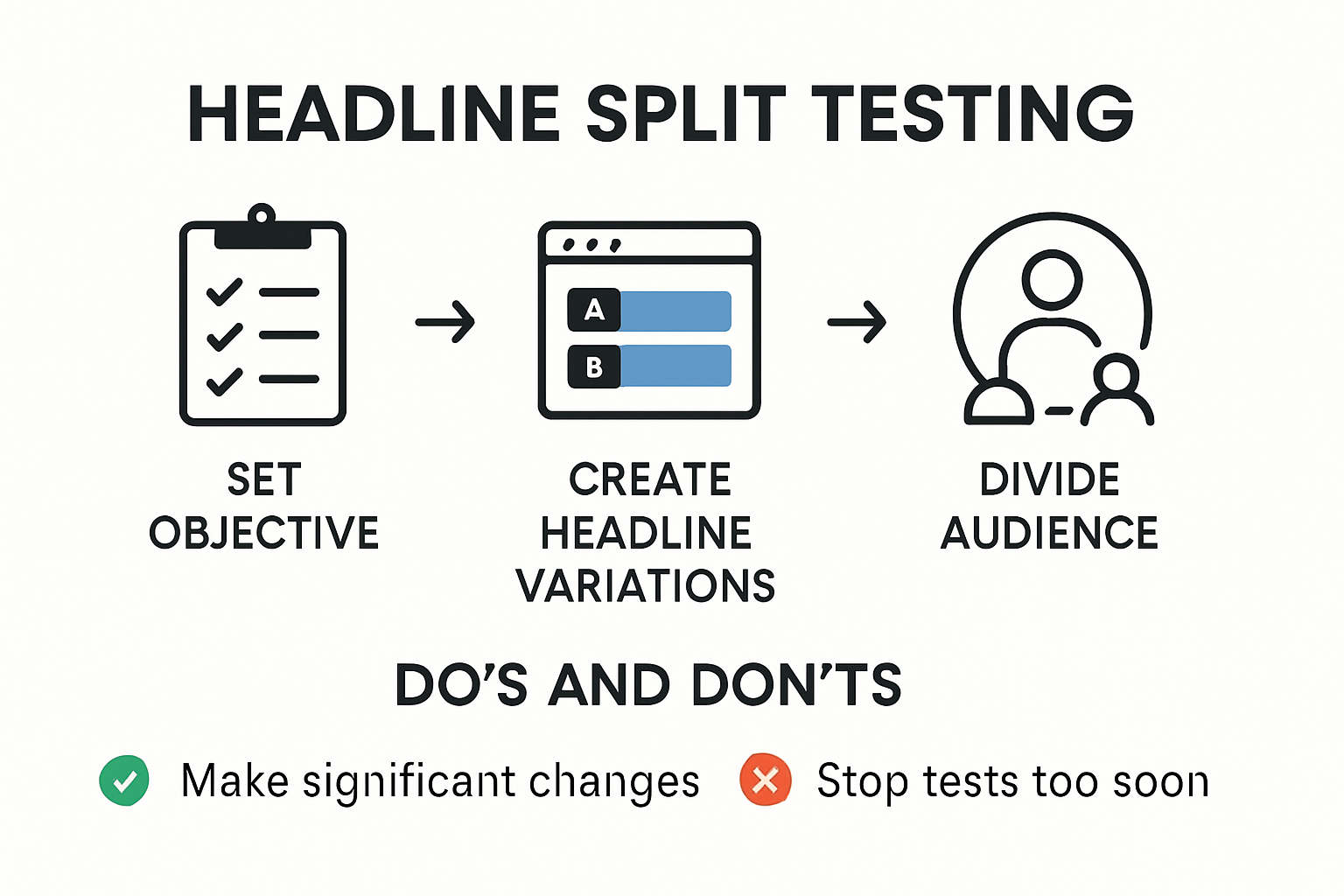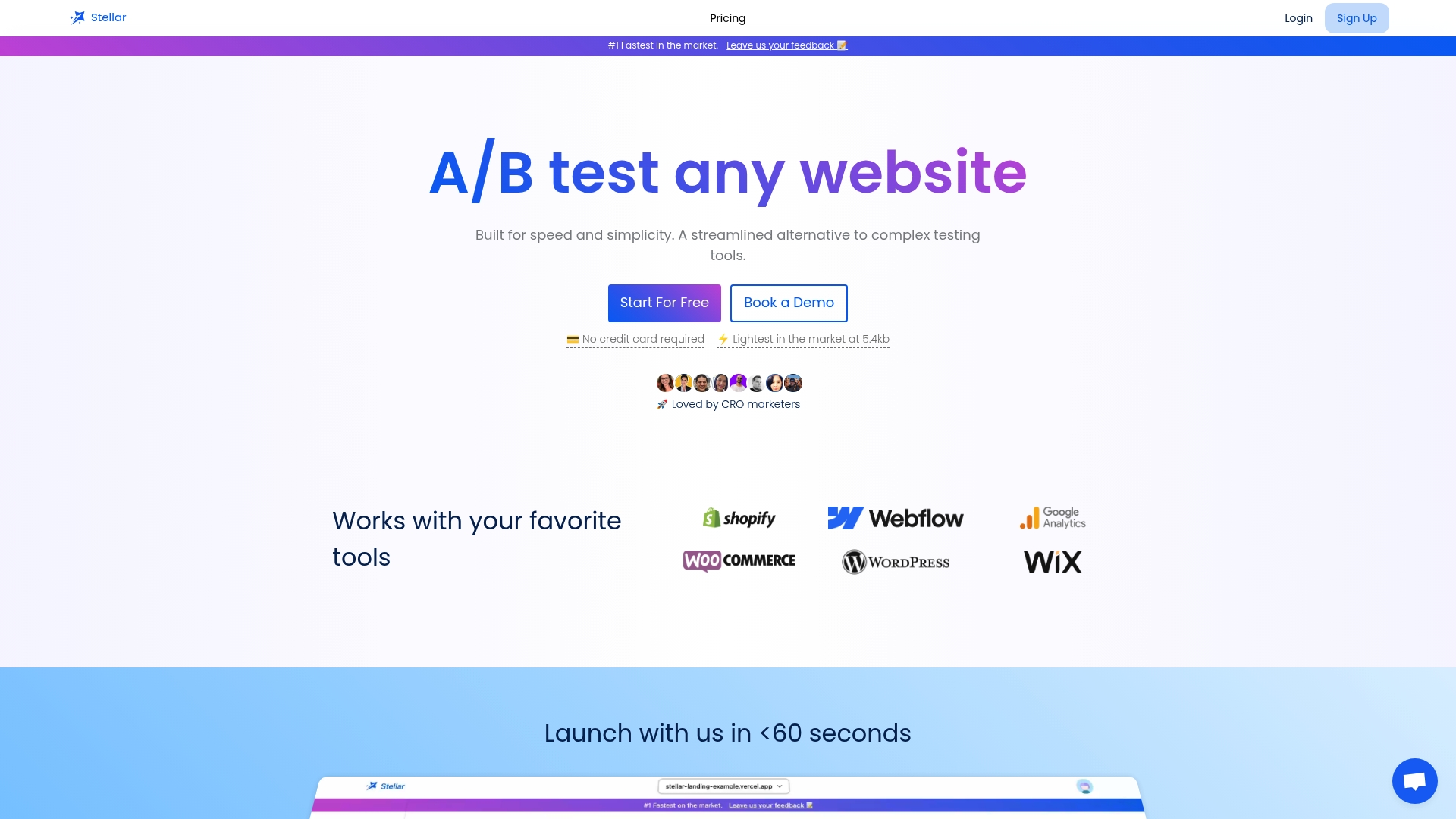
Split Testing Headlines: Proven Methods for Higher Conversions

Everyone talks about headlines as if they are just a catchy line at the top of your page. Most people ignore how much of a difference a simple headline test can make. Get this. Switching just one word in your headline can raise your click-through rate by over 10 percent. Surprised? Plenty of marketers still flip headlines on a whim or stick to old favorites and miss out on meaningful results. Instead, split testing turns headline writing into a science that lets you spot the winning formula with real data. The smart approach does not just grab eyes, it powers higher conversions every time.
Table of Contents
- Why Split Testing Headlines Drives Results
- Step-By-Step Guide To Running Headline Tests
- Common Pitfalls And How To Avoid Them
- Tips For Crafting High-Converting Test Headlines
Quick Summary
| Takeaway | Explanation |
|---|---|
| Split Testing Boosts Engagement | Systematic testing reveals which headlines capture audience attention and drive conversions effectively. |
| Use Psychological Triggers | Choose headlines that evoke emotions, curiosity, or urgency to enhance click-through rates. |
| Maintain Statistical Significance | Ensure tests have enough data to draw reliable conclusions; avoid premature interpretations. |
| Craft Distinct Variations | Test headlines that significantly differ in message rather than just minor changes for meaningful insights. |
| Regularly Update Tests | Audience preferences can change; continuous testing is essential for maintaining headline effectiveness. |
Why Split Testing Headlines Drives Results
Split testing headlines is not just a marketing tactic. It is a strategic approach that directly impacts conversion rates and user engagement. Understanding why split testing works requires examining the psychological and data driven mechanisms behind headline optimization.
The Psychology of Headline Effectiveness
Headlines serve as the first point of contact between your content and potential readers. Research from the Proceedings of the National Academy of Sciences demonstrates that randomized A/B testing for headlines can significantly increase user engagement. This means the words you choose have a profound impact on whether someone clicks, reads, or scrolls past your content.
Psychological triggers play a crucial role in headline performance. Different word combinations can evoke emotions, spark curiosity, or create a sense of urgency. By systematically testing variations, marketers can uncover which emotional and cognitive buttons drive higher conversion rates.
Data Driven Decision Making
The power of split testing headlines lies in its commitment to empirical evidence. Instead of relying on gut feelings or assumptions, marketers can collect concrete data about what resonates with their specific audience. Neil Patel's conversion optimization research reveals that even minor headline changes can produce dramatic shifts in engagement metrics.
For example, changing a single word can increase click through rates by 10% or more. This means headlines are not just decorative text but strategic tools that can be precisely tuned to maximize audience response. The systematic approach of split testing allows for continuous refinement and improvement.
Practical Implementation Strategies
Successful split testing requires a structured approach. Start by identifying the key performance indicators you want to improve. Are you seeking more clicks? Higher engagement? Increased conversions? Each goal might require a different headline strategy.
Create multiple headline variations that test different psychological triggers. These could include variations in:
- Emotional Tone: Comparing positive versus negative framing
- Specificity: Testing general statements against highly specific claims
- Length: Evaluating short punchy headlines versus more descriptive versions
Ensure you run tests long enough to gather statistically significant data. This means collecting enough impressions and interactions to draw reliable conclusions about which headline performs best.
Remember that split testing is an ongoing process. What works today might not work tomorrow as audience preferences and market dynamics shift. Continuous testing and adaptation are key to maintaining high conversion rates.
By embracing split testing headlines, marketers transform headline creation from a guessing game into a precise science. The result is more engaging content, higher click through rates, and ultimately, more successful marketing campaigns.
Step-by-Step Guide to Running Headline Tests
Executing effective headline tests requires a systematic and strategic approach. This guide will walk you through the essential steps to conduct meaningful split testing that delivers actionable insights and improves your conversion rates.
Preparing Your Headline Test
Before launching any split test, comprehensive preparation is crucial. KDnuggets' A/B testing guide emphasizes the importance of defining clear objectives and establishing precise measurement criteria. Start by identifying the specific goal of your headline test. Are you aiming to increase click-through rates, improve engagement, or boost conversions?
Develop multiple headline variations that explore different approaches. These variations should test distinct psychological triggers and messaging strategies. Aim for headlines that are fundamentally different, not just minor word swaps. Consider testing variations that explore:
- Emotional Framing: Positive vs. negative language
- Value Proposition: Benefit-driven vs. feature-focused messaging
- Urgency: Time-sensitive vs. evergreen approaches
Implementing the Test Methodology
Smashing Magazine's comprehensive A/B testing research highlights the critical importance of proper test implementation. Divide your audience randomly into control and test groups to ensure statistically valid results. This means each group should receive an equal and unbiased exposure to different headline variations.
Key implementation steps include:
- Sample Size: Determine an appropriate audience size that provides statistical significance
- Test Duration: Run the test long enough to collect meaningful data
- Tracking Metrics: Set up precise tracking for key performance indicators
Ensure your testing environment maintains consistent conditions across all variations. Factors like page layout, traffic sources, and timing can significantly impact results. Use a reliable A/B testing tool that provides accurate data collection and analysis.
Analyzing and Applying Test Results
Data interpretation is where many marketers falter. Look beyond surface-level metrics and dig into the underlying patterns. Statistical significance is crucial - a few random clicks do not constitute a reliable trend. Aim for a confidence level of at least 95% before drawing conclusions.
Consider multiple performance indicators:
- Click-Through Rate: Primary engagement metric
- Time on Page: Indicates content relevance
- Conversion Rate: Ultimate measure of headline effectiveness
Do not view split testing as a one-time event. Successful marketers treat headline optimization as an ongoing process of continuous improvement. Each test provides insights that inform future iterations, creating a cycle of incremental optimization.
Remember that audience preferences evolve. What works today might become less effective tomorrow. Regularly revisit and retest your headlines to stay aligned with changing audience expectations and market dynamics.
By following this structured approach, you transform headline creation from guesswork into a precise, data-driven strategy. The result is more compelling content that truly resonates with your target audience.
Common Pitfalls and How to Avoid Them
Split testing headlines can be a powerful optimization strategy, but many marketers fall into predictable traps that undermine their efforts. Understanding and avoiding these common pitfalls is crucial for extracting meaningful insights and driving real conversion improvements.
Statistical Significance Mistakes
One of the most frequent errors in headline testing is drawing conclusions from insufficient data. Conversion XL's statistical analysis research highlights that premature conclusions can lead to misguided marketing decisions. Statistical significance requires a robust sample size and adequate testing duration.
Marketers often make critical mistakes such as:
- Stopping Tests Too Early: Ending tests before collecting enough data points
- Ignoring Confidence Intervals: Failing to understand the range of potential variation
- Small Sample Sizes: Testing with too few participants, which skews results
To avoid these pitfalls, establish clear statistical thresholds before beginning your test. Aim for a 95% confidence level and ensure you have enough data points to make meaningful comparisons. This means running tests long enough to generate statistically significant results, typically at least one to two weeks depending on your traffic volume.
Testing Irrelevant Variations
Optimizely's experimentation guide emphasizes the importance of creating meaningful headline variations. Many marketers create tests that are too subtle or fundamentally similar, which produces inconclusive or negligible results.
Effective headline testing requires substantial differences that can reveal genuine insights. Consider testing variations that:
- Challenge Core Messaging: Explore fundamentally different value propositions
- Address Different Audience Motivations: Test emotional versus rational approaches
- Experiment with Structural Differences: Compare question-based versus statement-based headlines
Avoid making minor word changes that do not represent meaningful strategic shifts. Each headline variation should represent a distinct communication approach that could potentially resonate differently with your target audience.
Technical and Implementation Errors
Technical mistakes can invalidate even the most carefully designed headline tests. Common implementation errors include improper audience segmentation, inconsistent testing environments, and inadequate tracking mechanisms.
Key technical considerations include:
- Consistent Traffic Sources: Ensure test groups receive traffic from similar channels
- Uniform Page Conditions: Maintain identical page layouts and design elements
- Precise Tracking: Use robust analytics tools that capture comprehensive engagement metrics
Implement rigorous tracking protocols that capture nuanced user interactions. Look beyond simple click-through rates and examine deeper engagement metrics like time on page, scroll depth, and conversion actions.
Remember that split testing is not a one-time activity but an ongoing optimization process. Each test provides incremental learning, helping you refine your understanding of what truly motivates your audience.
By anticipating and avoiding these common pitfalls, you transform headline testing from a hit-or-miss strategy into a systematic approach for continuous marketing improvement. The key is patience, precision, and a commitment to data-driven decision making.
Here is a summary table outlining common pitfalls in headline split testing and practical strategies to avoid them. Use this table as a quick reference to ensure reliable and actionable test results.
| Pitfall | Description | How to Avoid |
|---|---|---|
| Stopping Tests Too Early | Ending tests before collecting enough data for significance | Set clear sample size and confidence thresholds |
| Ignoring Confidence Intervals | Overlooking variability in test results | Always use statistical significance calculations |
| Small Sample Sizes | Testing with too few participants, leading to unreliable conclusions | Ensure adequate audience size for each variation |
| Testing Irrelevant Variations | Using variations that are too similar to each other | Test distinct headline approaches and messages |
| Inconsistent Testing Environments | Changes in layout, traffic, or conditions during tests | Maintain uniform page and traffic conditions |
| Inadequate Tracking | Failing to measure all relevant engagement metrics | Use robust analytics for comprehensive data |

Tips for Crafting High-Converting Test Headlines
Crafting headlines that convert requires a strategic approach that blends psychological insight with data-driven techniques. Understanding how to create compelling headline variations can dramatically improve your marketing performance and audience engagement.
Emotional Trigger Strategies
Research analyzing online field experiments reveals that headlines incorporating negative emotion words and general language can achieve higher click-through rates. This counterintuitive insight suggests that emotional complexity plays a significant role in capturing audience attention.
Effective emotional trigger strategies include:
- Curiosity Gap: Create headlines that hint at valuable information without fully revealing it
- Urgency: Develop language that suggests time-sensitive opportunities
- Problem Resolution: Frame headlines as solutions to specific challenges
Avoid generic emotional manipulation. The goal is to create genuine emotional resonance that connects authentically with your audience's real needs and aspirations.
Structural Headline Frameworks
Communication research from media studies demonstrates that headline structure significantly impacts reader engagement. Develop a systematic approach to headline construction that explores different psychological approaches.
Consider testing headline frameworks such as:
- Numerical Frameworks: Headlines that include specific numbers or quantifiable outcomes
- Question-Based Approaches: Headlines that directly pose challenges or questions
- Benefit-Driven Statements: Clear declarations of value proposition
Each framework should be crafted to address specific audience motivations and communication contexts. The key is creating variations that fundamentally differ in approach and messaging strategy.
The following table summarizes key headline structures and emotional trigger strategies you can use to craft high-converting test headlines. Each approach serves a different psychological or strategic purpose.
| Headline Approach | Description | Example Strategy |
|---|---|---|
| Curiosity Gap | Creates intrigue by withholding key info | "You Won't Believe These Results" |
| Urgency | Encourages quick action or response | "Limited Time Offer: Act Now!" |
| Problem Resolution | Frames headline as a solution to a challenge | "How to Fix Broken Conversions Fast" |
| Numerical Framework | Uses numbers to promise specific value | "5 Ways to Double Your Traffic" |
| Question-Based | Asks directly about reader needs or pain points | "Are Your Headlines Costing You Clicks?" |
| Benefit-Driven Statement | States clear advantage or positive outcome | "Boost Engagement with One Simple Change" |
Advanced Headline Optimization Techniques
Sophisticated headline testing goes beyond simple word swaps. Focus on developing comprehensive variations that explore different communication strategies and audience perspectives.
Advanced optimization techniques include:
- Persona-Based Variations: Create headlines targeting specific audience segments
- Contextual Adaptations: Test headlines that respond to different user intent signals
- Linguistic Complexity: Experiment with varying levels of technical and conversational language
Pay close attention to subtle linguistic nuances. Small changes in word choice, sentence structure, and emotional framing can produce significant differences in audience response.
Remember that headline optimization is an iterative process. No single approach guarantees universal success. Continuous testing, careful analysis, and willingness to challenge existing assumptions are essential for developing truly compelling headlines.
By combining psychological insights, structural creativity, and rigorous testing methodologies, you can develop headline strategies that not only capture attention but drive meaningful audience engagement and conversion.

Frequently Asked Questions
What is split testing for headlines?
Split testing, also known as A/B testing, involves comparing two or more headline variations to determine which one performs better in terms of click-through rates and conversions. This method allows marketers to use data to make evidence-based decisions about headline effectiveness.
How can I improve my headline conversion rates?
To improve headline conversion rates, implement split testing to experiment with different variations, focusing on emotional triggers, structural frameworks, and psychological insights. Test different word combinations, tones, and formats to find what resonates best with your audience.
What are common pitfalls to avoid in headline testing?
Common pitfalls include stopping tests too early, testing irrelevant variations, and failing to ensure statistical significance. Maintain consistency in your testing environment and keep an eye on sample sizes to draw reliable conclusions.
How often should I run headline tests?
You should run headline tests regularly to adapt to changing audience preferences and market dynamics. Continuous testing is essential for maintaining effective headlines, as what resonates today may not work in the future.
Take the Uncertainty Out of Headline Testing with Stellar
Crafting the perfect headline is only the beginning. Real results come from acting on data, running structured split tests, and making changes with confidence. Yet many marketers struggle with tedious set-up, unreliable stats, and tools that slow down their site. If you are ready to stop guessing and see real conversion lifts, now is the time to try a faster, smarter way.

Imagine running A/B tests on your headlines in minutes, with a visual editor that needs no code and a script so small your site speed stays lightning fast. Stellar gives you instant feedback through real-time analytics and advanced goal tracking, so every tweak is backed by actionable insight. Get started on Stellar's landing page and join marketers who turn headline ideas into proven conversion boosts today. Test your first headline with Stellar now and see just how easy real results can be.
Recommended
Published: 8/11/2025
